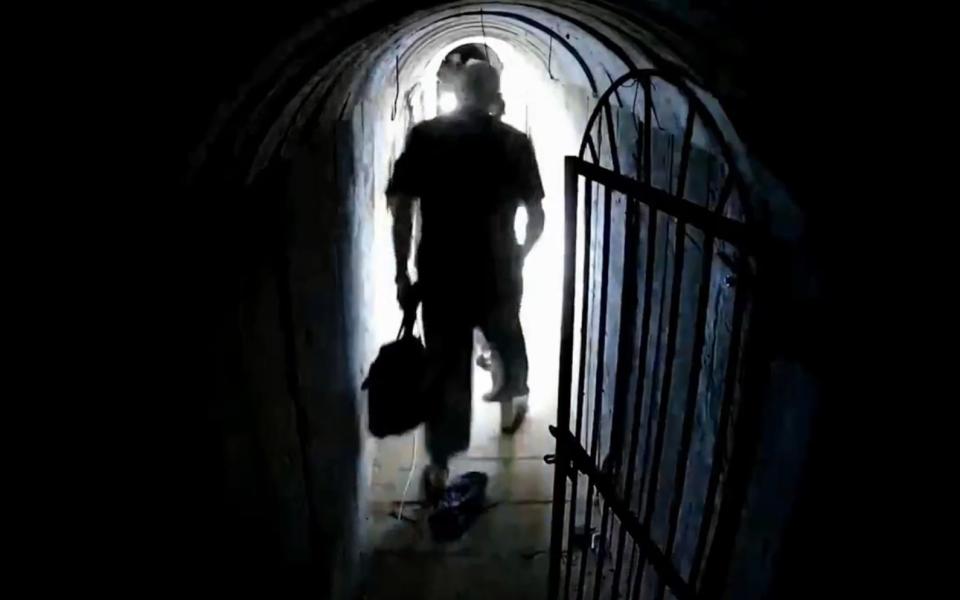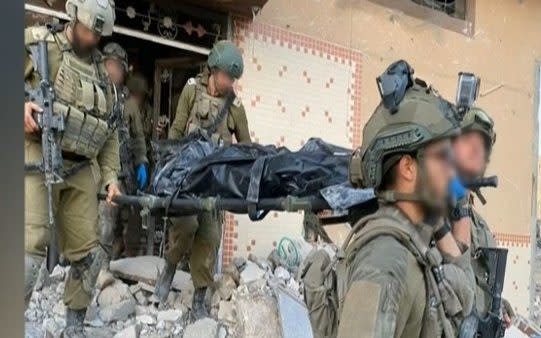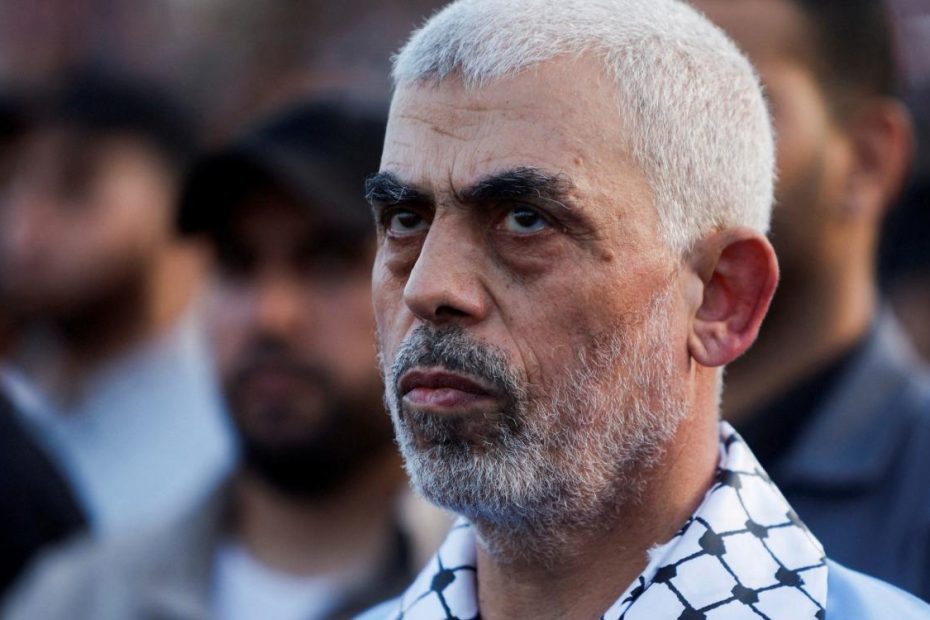After a year of hunting its most wanted target in the Hamas tunnels under Gaza, Israel appears to have claimed its prey in a chance encounter in the devastated streets of the coastal strip.
When Israeli forces saw Hamas fighters enter a building in Rafah, they had no reason to suspect that one of them was their country's most wanted man.
For months, a specialized elite task force had been searching for the terrorist leader behind the October 7 attacks, and it was widely believed that he was hidden deep underground.
The troops called for a tank to fire on the building, causing much of it to collapse, Israel's Channel 12 reported.
It was only when soldiers subsequently found three bodies in the rubble that they noticed how familiar one dead man seemed.
The dead middle-aged man, who was wearing a military-style vest and lay half-buried in rubble with the front of his head smashed, had a familiar-looking birthmark next to his left eye, troops noted.
Troops who entered the building decided he “looked very much like” Yahya Sinwar, the Hamas leader considered the architect of last year's Oct. 7 attack on Israel.
While he opened his lips with a piece of wood, troops also believed that his worn and chipped teeth matched photos of the Hamas leader's mouth.
Because the area where he was found was littered with booby traps and his vest contained at least three grenades, soldiers would not have been able to immediately recover the body.
A photo was later released of troops carrying the body, wrapped in a black body bag and strapped to a stretcher.
DNA samples were recovered for testing and photographs of his teeth were taken to compare with dental records.
The results were released by Israeli officials on Thursday evening, confirming that they had killed the leader of Hamas.
As news of the killing spread, Defense Secretary Yoav Gallant said the country would “reach out and eliminate every terrorist.”
Quoting the Bible book of Leviticus, he added: “You will pursue your enemies, and they will fall before you by the sword.”
A video released by an Israeli newspaper showed people on a beach in Tel Aviv clapping and cheering after a man said “Hello, Sinwar” over a loudspeaker.
“Well done IDF. No [terrorists] will stay. Whoever harms Israeli citizens will be the end of him,” the man speaking over the loudspeaker added.
Sinwar's death marked the end of a manhunt for the terrorist leader whom Israel had branded a 'dead man walking'. The attacks on October 7 marked the deadliest day for the state of Israel, as Hamas fighters overran southern Israel, killing around 1,200 people and taking some 250 hostages to Gaza.
The attack prompted massive Israeli retaliation against Hamas in Gaza, in a campaign of airstrikes and ground offensives that killed more than 42,000 people, the Hamas-led Health Ministry in the Gaza Strip said. Much of the strip has been destroyed and large numbers of people have been driven from their homes.


The Israeli army called Sinwar the “face of evil” and promised that he would be eliminated after the attacks.
But while many top Hamas leaders were assassinated in the months that followed, including deputies such as Marwan Issa and Mohammed Deif, Sinwar himself remained more elusive.
The only image of him released in the past year was grainy black and white footage of him walking through a tunnel with his family on October 10 last year.
The clip showed Sinwar, carrying a bag and slippers, as his children and wife walked through a tunnel under a cemetery in the Bani Suheila area, in Khan Younis.
Yet the fragment was not found until four months later, when Israeli soldiers arrived on the scene.
At the time, the Israeli military said the tunnel contained “bedrooms of senior Hamas officials and the office of the commander of the Eastern Battalion of the Khan Younis Brigade, from where he led the attack on October 7.”
Senior Hamas officials stayed at the compound in “comfortable conditions” with food and bathrooms, along with safes containing “personal funds of millions of shekels and dollars in cash.”
Because Sinwar was believed to be somewhere in the extensive network of tunnels that Israel said it had found under Gaza, the task of tracking him down fell to a task force of intelligence officers, special operations units, military engineers and surveillance experts .


As the months passed, Israeli officials repeatedly said they had gotten close to him.
In December, Netanyahu announced that Israeli forces had surrounded Sinwar's home in Khan Younis.
“I said last night that our troops could reach anywhere in the Gaza Strip. Now they surround Sinwar's house. His house is not his fortress, and while he may flee, it is only a matter of time before we catch him,” Netanyahu said.
In August, the outgoing commander of the IDF's 98th Division, Brigadier General Dan Goldfus, told Channel 12 that the army was “minutes” away from capturing the Hamas leader.
He said: “We were close. We were on his property. We came to an underground complex. We found a lot of money there. The coffee was still hot. Weapons distributed.”
As little information emerged about him, rumors also circulated that he was already dead.
Speculation had increased recently when it was noted that a recent government photo of a high-level military meeting showed a Hamas organizational chart with a question mark above Sinwar's head.
But US officials said earlier this month that although his communications had gone silent, there was no evidence he was dead and that they instead believed he was alive and still making decisions.
Their assessment of the fugitive was that he was isolated and hiding in Gaza.
This embedded content is not available in your region.
Fearing that communicating with an electronic device would cause him to be quickly tracked down by electronic eavesdropping, he instead resorted to a network of human couriers.
Aware that Israel was closing in on him, and having seen several of his high comrades murdered by Israel, he had long since decided that he would not survive the war.
But just as he was more fatalistic, he was also considered increasingly inflexible.
Sinwar was determined to see Israel become embroiled in a broader regional conflict that would force Benjamin Netanyahu to scale back his offensive in Gaza.
As his stance hardened, it was believed that he had no intention of reaching an agreement with Israel to end the conflict.
Israeli hostages also said they met him during their captivity, when he spoke to them in almost accent-free Hebrew to reassure them after they were marched into Gaza.
At other times, Israeli officials said they believed he was hiding in tunnels surrounded by hostages using them as human shields to avoid airstrikes.
Israel said no hostages were found in the building where his body was recovered.
When the end came, Hamas sources said he was surrounded by a security guard of no more than two or three people.
Broaden your horizons with award-winning British journalism. Try The Telegraph free for 3 months with unlimited access to our award-winning website, exclusive app, money-saving offers and more.

